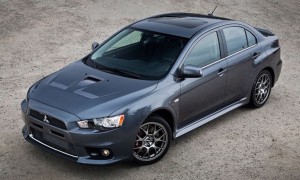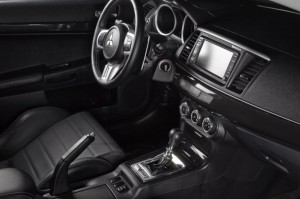 The freeway would have been fine for the return trip from the NASCAR race at Michigan International Speedway, but why take the easy route when there’s a great twisty dirt road to take instead?
The freeway would have been fine for the return trip from the NASCAR race at Michigan International Speedway, but why take the easy route when there’s a great twisty dirt road to take instead?
Dirt is where Mitsubishi’s legendary Lancer Evolution MR was developed, cutting its teeth on the World Rally Championship circuit.
The Evo was in its element. Somehow, it seemed to have a smoother ride on the dirt than on tarmac. Impossible, but large bumps that seemed likely to bounce us out of our seats caused only a minor disruption in the car.
With the Evo’s sophisticated Super All-Wheel Control set to gravel – there are settings for tarmac and snow as well – and the automated manual transmission in manual shift mode, the Evo charged through turns, gripping the loose surface as if it had grappling hooks. With all four wheels searching for grip, the Evo seemed every bit as fast as on pavement.
Video game mavens know all about the Evo. Unofficially known as Evo X for 10th generation, Mitsubishi has resisted the common urge to make the Evo smoother and more sophisticated. Over the years, it’s grown in size, but this is still one extroverted little sedan, worthy of its reputation as the ultimate pocket rocket.
This is a car that presses up hard against $42,000, but many of the interior bits – besides the phenomenal leather Recaro seats – come straight out of the basic Lancer sedan, which starts at less than $16,000.

Mitsubishi's Evo may start at more than $34,000, but its interior is largely lifted from its $16,000 sibling.
If it’s luxury and refinement you’re looking for, stop reading. You can get a whole lot of Cadillac – or BMW or Mercedes or Lexus or (insert your favorite luxury brand here) – for this kind of money.
What you won’t get is a wicked 291-horsepower turbocharged 2.0-liter four cylinder or a bunch of other hardware that essentially turn Mitsubishi’s least-expensive car into a bonafide race car. Seriously, bolt in a roll cage and give it a x-point racing harness and you’ll be welcome at the track.
Evos start at $34,335 including destination for the GSR model with a five-speed manual transmission. Bump up to the MR for $39,735 and you get an excellent six-speed dual-clutch automated manual transmission that Mitsubishi calls Twin-Clutch Sportronic-Shift (TC-SST), magnesium paddle shifters and 18-inch forged BBS alloy wheels. The MR-Touring tested here adds some luxury goodies such as the Leather Recaros, rain-sensing wipers, sunroof, automatic headlights and additional sound deadening for another $2,000 on top of the regular MR’s price. Touring models also trade the regular Evo’s outrageous rear wing for a small lip spoiler.
Fifty-four hundred dollars seems like a steep price to pay for the auto trans and better wheels, but the transmission is a blast to use in fast driving.
Automated manual transmissions have automated clutches, eliminating the traditional manual’s third pedal. Two clutches allow the trans to queue up the next gear while cruising in another, making shifts almost instantaneously, far faster than is possible in a traditional manual or automatic.
The Evo can be shifted via a slot off to the left of the regular PRND or with the large paddles behind the steering wheel. Mitsubishi has the paddles right, mounting them to steering column, instead of the wheel, so they’re always in the right place. Making less sense is the transmission lever, which you push forward for a lower gear and pull back for an upshift. That seems backward. Better to stick to the paddles anyway since that allows you to keep your hands on the wheel.
The transmission does a reasonable impersonation of a traditional automatic when you let it shift for itself. It tends to hold gears a little too long, causing the engine to run rough. But if you want a lower gear, all you have to do is pull back on the left paddle and you get a nearly instantaneous downshift. Pull and hold the upshift paddle on the right to return to automatic mode or it will go back when the vehicle stops.
The transmission also has an automatic sport mode, which holds lower gears longer and downshifts more quickly. Cruise control is disabled in sport mode.
The Recaro seats are deeply bolstered. Their comfort is inversely related to the width of the occupants’ backsides. Climbing in over the deep side bolsters requires a bit of gymnastic ability. Surprisingly, adjustments on Recaros are fully manual.
The rear seats, also leather on the MR-Touring, were comfortable and surprisingly roomy. The sunroof reduces headroom slightly, but it’s still acceptable.
The trunk on the other hand is shockingly small. Mitsubishi relocated the washer fluid and battery to the trunk for better weight distribution. Combined with the Rockford Fosgate sound system’s huge subwoofer, which is also located in the trunk, there is just 6.9 cubic feet of space, compared to 12.3 cubes for the base car.
Mitsubishi made extensive use of aluminum in the Evo to keep weight down, but it still weighs 584 pounds more than a manual transmission Lancer GTS. Aluminum is used for the hood, front fenders and both bumper beams.
Fuel mileage probably won’t be a major consideration for Evo buyers, but the car’s poor numbers are worth mentioning. Evos with the TC-SST transmission are rated at 17 city and 22 highway, while manual transmission versions lose 1 mpg on the city cycle. Also, the fuel tank is just 14.5 gallons, giving the car a theoretical 319-mile freeway range.
But you won’t be thinking about the tiny fuel tank or econocar interior as you wind the screaming turbo past its 7,000-rpm redline (there’s a rev limiter at 7,300 rpm) and search for corners to blitz through. There’s significant turbo lag below 2,000 rpm, but the engine makes tons of power up to and past it’s 6,500 horsepower peak.
There’s a lot of advanced hardware that gets the power to the road. Active Center Differential sends power to the end of the car which has the most traction. Active Yaw Control senses rear-wheel spin and routes power to the wheel with the best grip, which enhances high-speed cornering. The Evo has Active Stability Control, but Mitsubishi says that the system is not used to prevent wheelspin, as it is on some all-wheel drive vehicles. The stability control and yaw control can both be turned off for track sessions.
It all makes for one of the most advanced drive systems of any car on the market.
The steering adds to the car’s quick reflexes and cornering ability. Surprisingly, the Evo tracks smoothly on the freeway, so long as the wide tires don’t have huge ruts in the asphalt to contend with.
Buy one and you’ll find yourself seeking out deserted dirt roads to test the Evo’s rally-bred handling.
